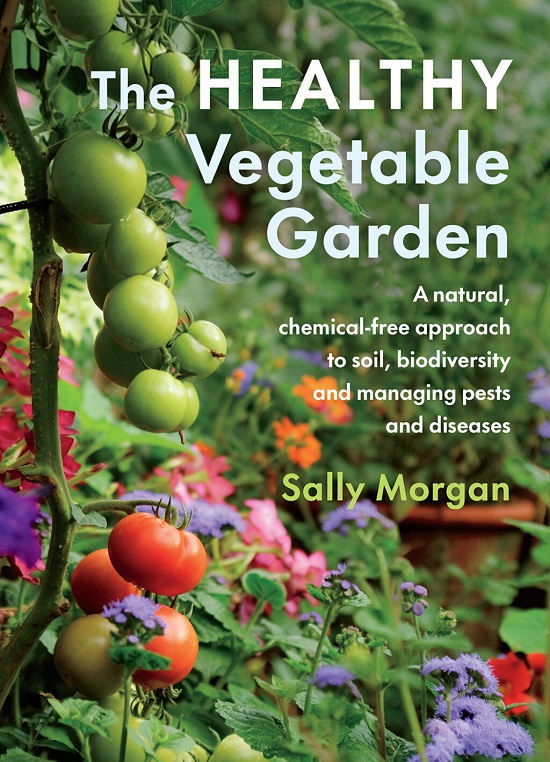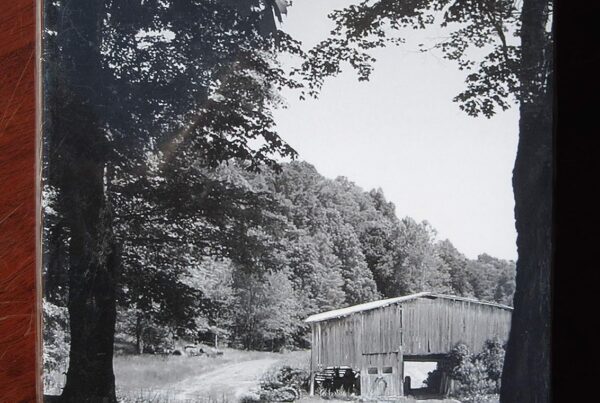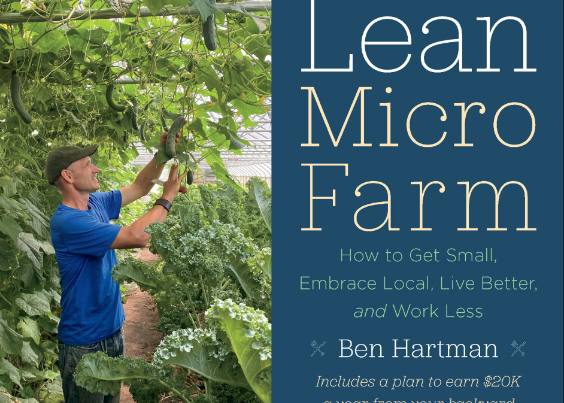
By Sally Morgan
Chelsea Green Publishing, September 2021
Sally Morgan is an expert organic gardener in the UK. She is the editor of Organic Farming Magazine for the Soil Association, the nation’s foremost non-profit organic gardening and farming membership organization. Her book The Healthy Vegetable Garden is clearly and concisely written. Sally promotes building healthy soil, boosting biodiversity, creating habitats to attract pollinators and predators, making good use of water, promoting the stability and resilience of natural ecosystems, and integrating the landscape with people.
A healthy garden maintains a balance where pest organisms are at an undamaging level, (rather than eliminated entirely). Here you will find lots of solid information to identify pests and diseases and deal with them using regenerative principles, and when necessary, making traps and lures.
The book has some info particularly for US gardeners – you’ll be able to read about Mexican bean beetle and Colorado potato beetle! You might be mystified by some of the European details we don’t have to deal with, such as raspberry beetle or flatworms. As long as you have some prior gardening experience where you live now, you can only benefit from the information offered here. Brand new US gardeners might get confused.
The Healthy Vegetable Garden has good descriptions of soil and its components, structure, assessment, and testing. It is important to nurture healthy soils producing healthy plants, with the essential minerals and vitamins we need for health. Nutrient density has declined seriously over the last 70 years, particularly levels of calcium, iron and vitamins B and C. In 2014, the UN warned that we had only 60 years of harvests left, if we continued degrading our soils. In 2020 a new study estimated that 90% of soils had only 100 years of harvests left. Soils managed with conservation techniques have much longer projected lifespans.
The second chapter is about ways to regenerate soils, by minimizing tilling or digging, adding compost, mulches and cover crops. The living mulch section is where I am hesitant. My experience and that of Jesse Frost whose Living Soil Handbook I reviewed recently, is that living mulches can out-compete the crop if we are not skilled and careful. The author does point out the need to cut back the mulch to prevent this problem. Growers in the south might find planting zucchini (courgettes) into white clover impractical as zucchini is a fast-turnaround crop for us, whereas clover is a slow-growing cover crop. The author leaves the clover growing through the following winter, to make the combo work. In the chillier parts of the UK, only one crop of zucchini can be grown in a summer, so the system makes sense. In Virginia, we plant zucchini and summer squash 5 times outdoors. Likewise, the speed with which chickweed flowers and sets seed in Virginia would make it unwise to regard it as a cover crop! I did like the idea of undersowing tomatoes with coriander, if I wanted large volumes of coriander (cilantro).
The chapter on understanding pests and diseases is well-written, although we in the US have so many more than in the UK! Plant pests are listed in categories by their method of causing harm, rather than by individual names, which helps understanding. Plant pathogens likewise are described by type, as bacteria, viruses, fungi, water-molds. Fungal pathogens include biotrophs (parasitic pathogens such as downy mildews, rusts and smuts), semi-biotrophs that spend part of their lifecycle on the host, then part feeding saprophytically on the host’s dead remains (such as apple scab, Phytophthora blights, Botrytis-type molds and powdery mildews) and necrotrophs that kill their host and then feed as saprophytes. I appreciated the bigger understanding this classification of pathogenic fungi gave me.
Heed the warning that climate change is bringing new pests and diseases, and the chilling news that for every 1Celsius degree rise in average temperature (about 2 F degrees), aphids become active two weeks earlier. Some warm climate diseases will move further towards the poles. The author recommends paying attention, encouraging good airflow around plants, sanitizing pruning tools, and planting rows of tall plants to break up the progress of air-borne fungal spores. Growing potatoes downwind of a row of Jerusalem artichokes is a good example.
Sally is very practical on the subject of sterilizing pots and flats – your tools, boots, gloves and hands are as likely to spread spores, don’t worry about sterilizing pots! Some of the disinfectants suggested in other books can do more damage! Likewise, most spores don’t survive long on the ground, removed from their host plants, and so such diseased crops can be safely composted in a hot compost process. Practice crop rotation to deplete those that do survive in the soil, such as carrot rust flies.
Under normal conditions, predators can prevent pest outbreaks, but problems arise when conditions change quickly and disrupt the balance of prey and predator. If you see lots of pests, find a way to deal with them that won’t also kill their predators and parasites. Beware broad spectrum pesticides and fungicides, even if Organic. Encourage ladybugs and beetles by creating “ladybug hotels” and “beetle banks”. (There are some photos to inspire you.)
Plant for a continuous supply of insect-attracting blooms. Yarrow, ajuga, alyssum, dill, and fennel flower early in the year and attract predators like hoverflies, ladybugs, lacewings, tachinid flies, and parasitic wasps. Also grow early blooming flowers with pollen and nectar predators can use as alternative foods – borage is fast at producing nectar, as are dandelions. Phacelia is a very attractive to predators, especially aphid predators like hoverflies and parasitic wasps. Sow in the fall for early spring blooms. Angelica is a biennial that can flower in the spring of its second year. If you decide to trust to weeds to feed your beneficial insects, take care about how much seed they sow! This is a risk I do not recommend taking, especially in warm climates with rapid rates of growth.
In the section on crop rotations, polyculture and continuous cropping, Sally reports that she has moved away from a rigid crop rotation for many crops, following Elaine Ingham’s observation that nature does not rotate. This may be a place where home gardeners and production gardeners diverge. Mixed beds with several crops work well for manual work, but less so for those with rototillers, or even those hoping to make fast progress with a scuffle hoe. Mixed plantings are attractive and fun for the solo gardener, but having others pull up your delightful medley suggests it doesn’t work so well for bigger operations.
This book is not dogmatic. Rotations help disrupt pest and disease cycles, and here you can read brief descriptions of three-crop, four-crop and eight-crop rotations. You can also devise ad-hoc rotations and grow beds of different crops next to each other, in order to benefit from diversity without slowing down your hoeing or putting a bed out of commission while you wait for the last item in that bed to finish its lifecycle.
Shumei Natural Agriculture Farm, Yatesbury, Calne, in SW England has been increasing yields year by year, with no rotation, no pesticides, and no fertilizers other than material from immediately around the beds that is incorporated into the soil. You can’t successfully switch instantly to this method of growing, because it takes time and lots of the right microbes for the soil to adapt. Charles Dowding is experimenting with this at Homeacres, his garden in Somerset. Continuous cropping is a challenging idea to those of us who came up when organics was the opposite of industrial monocropping. We championed rotations.
The author provides a list of perennial vegetables she is growing: Chinese artichokes, Jerusalem artichokes, globe artichokes, Good king henry, lovage, perennial kales, scorzonera, sea beet, sea kale, skirret, Babington leeks, potato onions, walking onions, and Welsh onions. No rotation is used for these no-dig crops, which grow with a layer of leaf litter on the soil.
Agroforestry is the practice of growing vegetables in wide alleys between trees. Sally has tried this by planting a row of cordon apples (trees trained to a single stem) along the edge of a vegetable bed. US readers should not follow her exact hedge design plan, as autumn olive, blackthorn and dog rose, for example, are invasive here.
Part 4 of the book is on boosting defenses, and how biocontrol works. This is the use of one organism to control a pest or disease. It is important to learn about the pests you have and their particular biocontrols. It’s not a case of opening the bag and throwing the stuff on! Biocontrols have specific requirements, such as temperature or moisture. Timing is important.
Parasitic wasps, minute pirate bugs and predatory mites like Phystoseilus persimilis (which eats spider mites) can be introduced for their appropriate prey. Try to save biocontrols for when you really have a problem, and make sure you correctly identify the pest you want to control.
Predatory nematodes each have their own mutualistic bacteria living in their gut. When the predatory nematode works its way into its prey, it releases its bacteria, which kill and digest the prey. Reminds me of the Trojan Horse! The process happens below ground – nothing to see here! I found this fascinating! Nematodes need a film of water to live and move in, and temperatures above 41˚F (5˚C). Buy the right nematodes (and bacteria) for each job. This book has a two-page spread on which parasitic nematode to use for which pest. I have not seen this quality of information in any other book! Nematodes can be used to manage slugs, weevils, carrot rust fly, cutworms, onion fly, gooseberry sawfly, thrips, codling moth and more.
Plants have their own protective species. The introduction to the rhizosphere (microbiome around the roots) includes fascinating details on a type of morel mushroom that farms bacteria! Soil fungi are important for most crops, except brassicas and chenopods (beets, spinach and chard). We hear about the rhizosphere, but not the phyllosphere, the equivalent collection of micro-organisms on the leaves. This is mainly, but not only, composed of bacteria. About 10 billion on one leaf, and all different from the bacteria in the soil, and varying from one crop to another! Young leaves have mostly bacteria, mature leaves have more yeasts and senescent leaves mostly filamentous fungi. These microbes protect the plant’s health, supply biofertilizers, biostimulants and biopesticides. Some leaf bacteria suppress growth in caterpillars feeding on the leaf. Understanding this helps us appreciate the reasons for not spraying plants haphazardly with things that “might help”.
Plants have an arsenal of defenses. Thorns and hairs are just the most obvious. Some plants stockpile toxins to provide fast response to insect attack, others manufacture them as needed. When attacked, many plants respond by toughening up their cell walls in the area being attacked. Plants release various volatile compounds communicating with other plants and with insects (both the pests and predators of those pests). The example given is that when corn roots are attacked by a certain larva, the roots release a compound that attracts a nematode that is a predator of that larva. Sometimes, though, the attacker wins, as when certain beetles release their own volatile compounds in response to a plant’s compounds, signaling to other beetles to join the attack. Colorado potato beetles do this. This complexity calls our interventions into question: is it helpful to handpick the pests? Not if the pests call on comrades to join the fight.
If your soil is already healthy and rich in microbes, Sally thinks additions are not needed, including biostimulants, compost teas and foliar sprays to boost the numbers of beneficial bacteria and fungi. Biofungicides can prevent particular soil-borne diseases, but can’t cure them after the fact. Biofumigation is the process of growing a particular cover crop, chopping it finely and incorporating it into the oil, taking advantage of the allelopathic compounds released, to kill pests, diseases or weed seeds. Mustards, radishes and forage sorghum all have biofumigant properties.
The chapter on barriers, lures, traps and sprays includes recipes, and the caution that many homemade sprays kill beneficials as well as pests, as do some of the Organic commercial sprays like neem, Spinosad, quassia. Use these only as a last resort, and pay attention to dilution rates, time of day to spray and frequency of use.
Here you can find instructions for carefully treating seeds with a disease-fighting hot water treatment before planting. You can also find cautions, such as not heat-treating peas, beans, corn, cucumbers, lettuce or beets. Or old seed, as the germination rate might deteriorate too far.
Part 5 of the book is an A-Z of Pests and Disease. First are aphids – there are so many kinds of aphids! The lifecycle of aphids starts in spring with eggs hatching into wingless females that give birth via parthenogenesis to more females. Within a week, one female can produce 100 clones, which can repeat the process at the age of one week. This continues until adverse weather or predators trigger production of a generation of winged female aphids that moves to new plants. Later in summer male aphids are born and females lay fertilized eggs that overwinter on host plants, to hatch the following spring.
Handpicking aphids is likely impossible, so start by blasting them off the plants with a water jet from a hose. This may decrease the population enough for natural predators to begin control. Failing this, a soap spray can be effective, although aphid predators will also be harmed. If you plant before any aphids arrive, you can use a fine mesh netting to keep them off, but monitor to make sure no aphids have got inside the net. You could try trap crops of nasturtiums to draw aphids away from your crop, but how much of your space do you want to devote to nasturtiums, and how do you deal with aphids then? The same choices of water and soap.
The list of pests continues through the alphabet. For some, nasturtiums can act as a repellent rather than a trap crop. Cucumber beetles are a good example. Nasturtiums are a brassica, and will attract cabbage caterpillars if there are no other brassicas around. There are two pages on making the garden inhospitable to slugs and snails and three pages of control options including beneficial nematodes, ducks, coffee grounds (acidic and non-specific) and iron phosphate pellets. Finally, there are whitefly and wireworms.
The disease chapter starts with various blights, including two pages on potato blight (both types). Cankers, club root, damping off fungi, mildews, molds, rots, rusts, spots, scabs, viruses, and on with the sad list to end with wilts. It makes sense in an organizational way to end with the problems, but it makes for a sorry place to leave off.
This book is good on detailed info on soil micro-organisms and the general theme works globally. I recommend checking against local Extension Service or eOrganic before following any of the specific techniques, to ensure it’s likely to succeed where you live.







